A quick oddity that I found! Not even at the super-exotic place - these were in the fruit section of Whole Foods.

At first glance, these look like the kind of peppers that would literally blow your head off if you put more than one in your mouth at a time - and for that reason I was kind of hesitant to try them. But they're a species of grape - Teardrop Grapes, which have also been called Witch Finger Grapes before someone from marketing decided to make them sound more appetizing.
They taste very much like sweet red grapes, and so I thought this post would end on an anticlimactic note. But when looking for more information, I found that this is the first example I've found of a proprietary fruit! They didn't exist at all before 2002, when a farm in California called the Grapery began growing them through selective breeding, and they're still only available through that one farm. They have multiple varieties of grapes that they've invented with their mad grape Frankenstein science, each with a very limited window of availability each year - Teardrop grapes are only around for a month out of the year, from mid-July to mid-August, so the window is closing on them already.
There's an article about them in Bon Appetit here - what a fascinating find.

They taste very much like sweet red grapes, and so I thought this post would end on an anticlimactic note. But when looking for more information, I found that this is the first example I've found of a proprietary fruit! They didn't exist at all before 2002, when a farm in California called the Grapery began growing them through selective breeding, and they're still only available through that one farm. They have multiple varieties of grapes that they've invented with their mad grape Frankenstein science, each with a very limited window of availability each year - Teardrop grapes are only around for a month out of the year, from mid-July to mid-August, so the window is closing on them already.
There's an article about them in Bon Appetit here - what a fascinating find.
2017-08-11 20:20:00
Comment on this entry
I discovered a new fruit at Russo's! This one doesn't really look a whole lot like anything, and if you live in a remote place with houses built into mountains to hide from the Vikings like I did, even the thing that you think it might be is a trick.

This is a Hawaiian plantain. We don't get any kinds of plantains in Scotland, and they're disingenuous at the best of times - they look like mutant Incredible Hulk bananas, bigger and greener, but taste closer to a potato because they have so much starch in them. This one is a particularly fat variant of the family, with a shape almost like an American cucumber, and is ripe when it's banana-yellow.
Plantains are usually cooked to soften them because of the high starch content, but this variety is polymorphic - you can use it like that as a vegetable when it's yellow, or wait a bit longer and eat it as a fruit when it gets to this decrepit rotting state.

In my searches for how to effectively prepare and eat this, I was immeasurably delighted to discover Bananas.org, a thriving community that I had no reason to think ever existed. It is a hub for banana enthusiasts to post about their banana collections and share banana photos and stories - a whole subforum is dedicated to banana identification (both ornamental and edible) for people who have some plants that they don't quite know the sub-genus of. There is also a marketplace for people to auction or trade their bananas, with the eventual goal of catching them all and assembling a giant banana monster to destroy those pretentious Apple fans.

Still - when you cut it open you have a very traditionally banana-like appearance inside, with maybe a bit of a larger core area. It also has skin thinner than the American president, and is awkward to peel off without leaving residue behind - I used a knife to carve it off. At this very ripe stage, the interior tastes very much like the bananas that we're more familiar with, but still with a lingering starchy texture towards the middle.
So on the advice of the Internet, I made up a sugary batter, sliced the whole thing into thin discs, dipped them in, fried them a bit, and...

...hmm. Sorry, these actually appear to be pancakes. Perhaps I made the batter a little too thick (I wasn't really measuring because I was making so little), but what resulted was little pancakes with hot plantain inside. In pictures I've seen, the batter shell is supposed to be thinner and less enveloping, but the result was still good - they're commonly eaten with honey, but being Scottish, I used golden syrup.

Plantains are usually cooked to soften them because of the high starch content, but this variety is polymorphic - you can use it like that as a vegetable when it's yellow, or wait a bit longer and eat it as a fruit when it gets to this decrepit rotting state.

In my searches for how to effectively prepare and eat this, I was immeasurably delighted to discover Bananas.org, a thriving community that I had no reason to think ever existed. It is a hub for banana enthusiasts to post about their banana collections and share banana photos and stories - a whole subforum is dedicated to banana identification (both ornamental and edible) for people who have some plants that they don't quite know the sub-genus of. There is also a marketplace for people to auction or trade their bananas, with the eventual goal of catching them all and assembling a giant banana monster to destroy those pretentious Apple fans.

Still - when you cut it open you have a very traditionally banana-like appearance inside, with maybe a bit of a larger core area. It also has skin thinner than the American president, and is awkward to peel off without leaving residue behind - I used a knife to carve it off. At this very ripe stage, the interior tastes very much like the bananas that we're more familiar with, but still with a lingering starchy texture towards the middle.
So on the advice of the Internet, I made up a sugary batter, sliced the whole thing into thin discs, dipped them in, fried them a bit, and...

...hmm. Sorry, these actually appear to be pancakes. Perhaps I made the batter a little too thick (I wasn't really measuring because I was making so little), but what resulted was little pancakes with hot plantain inside. In pictures I've seen, the batter shell is supposed to be thinner and less enveloping, but the result was still good - they're commonly eaten with honey, but being Scottish, I used golden syrup.
2017-04-01 11:48:00
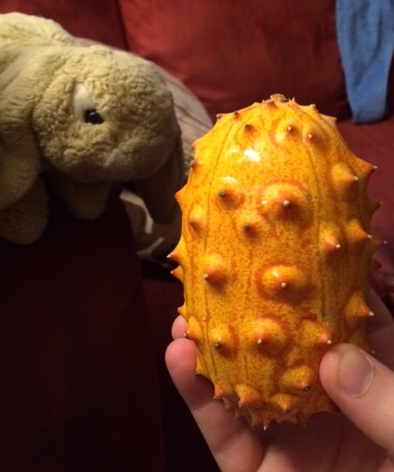 Back in the days when I used to write things that were interesting, I did an occasional series on the unlikely cosmic fruits and vegetables that were on display in Russo's, the import market near our town. I haven't tried anything new from there in a while, but I was surprised to find this spiked battle-fruit in the normal supermarket - it fascinated me so much that I just had to bring it home and try it.
Back in the days when I used to write things that were interesting, I did an occasional series on the unlikely cosmic fruits and vegetables that were on display in Russo's, the import market near our town. I haven't tried anything new from there in a while, but I was surprised to find this spiked battle-fruit in the normal supermarket - it fascinated me so much that I just had to bring it home and try it.Once you've avoided injury and got it open with a knife, you're faced with this nonsense.
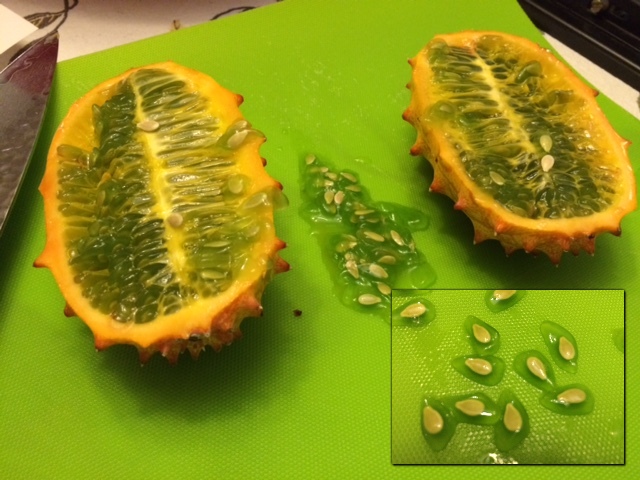
The contents at first glance are a jumble of green juice and seeds, but if you scrape them out and separate them, you'll notice that these are actually small triangular sacs of jelly-like flesh that each contain a seed at the centre, looking rather like something you would have to laser and excise in the later levels of a Trauma Center game. I'm not really sure how to approach eating it - I saw recommendations to just eat mouthfuls of the mixture and spit out the seeds but this is impossible, because the seeds are too small to really get a handle on in your mouth. They're not unpleasant to swallow, but it would be much more satisfactory if I could find a way of getting rid of them - perhaps sieving it into a juice?
As for taste, it took me a while to identify, as many of these fruits seem to fall somewhere on an indescribable range between cucumber and melon - but I realized after reading around that what it reminded me of was very specific - it's like eating a banana that isn't quite ripe yet, which has had a few drops of lemon juice spilled on to it. Its texture is different, but the taste is unmistakable once you realize it - it even has the same stringy, starchy and dry aftertaste that you feel in your mouth while regretting you didn't leave a banana until later. Apparently this is what the horned melon is meant to taste like when ripe, so I feel the banana is superior in virtually all respects.
As a last note, if not eaten when ripe it will allegedly explode to release its seeds, so perhaps this fruit is better suited as a weapon after all.
2015-10-13 18:59:00
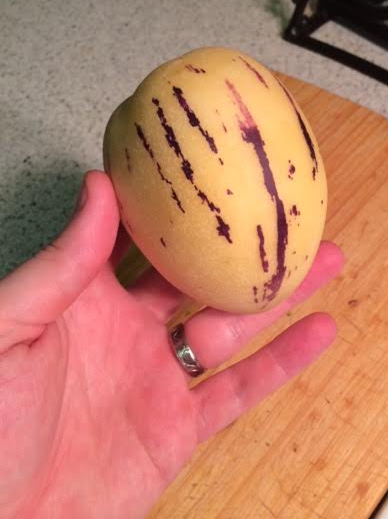 It's been a while since I've done this! As my image hosting has had to move, here's a hastily-assembled page of these brave experiments. The premise is simple - on the other side of the town from our house is an import market with an incredible fruit and vegetable section, some of which aren't even from this planet. I try to pick an unusual-looking one out every time we go, and then attempt to eat it if I can find out how to do so.
It's been a while since I've done this! As my image hosting has had to move, here's a hastily-assembled page of these brave experiments. The premise is simple - on the other side of the town from our house is an import market with an incredible fruit and vegetable section, some of which aren't even from this planet. I try to pick an unusual-looking one out every time we go, and then attempt to eat it if I can find out how to do so.Anyway. When you cut it in half, you get something that is close enough to a melon, with flesh around the outside and seeds in the centre - the skin, despite its soft and inviting texture, isn't usually eaten. You can scoop out the seeds and eat it with a spoon, or cut it into slices - the one I had here was a little overripe and so I could just carve the halves out of the skin.
It tastes like a pear that wanted to grow up different. The texture is almost identical to a ripe pear - juicy but a tiny bit mealy - but the taste has hints of cucumber to it, something that I hadn't really identified until I saw it mentioned in the Wikipedia article. It's a little unusual, but I wouldn't mind having this one again. A successful venture!
2014-08-13 20:16:00
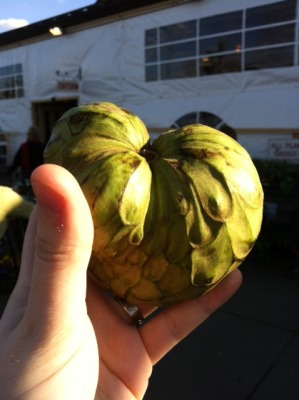 Here's another unidentified greenish object, photographed just outside its native habitat in the supermarket of madness. (The material in the background is a tarpaulin cover that they put over the outdoor fruit section when it rains - the supermarket is not inflatable.)
Here's another unidentified greenish object, photographed just outside its native habitat in the supermarket of madness. (The material in the background is a tarpaulin cover that they put over the outdoor fruit section when it rains - the supermarket is not inflatable.)Inside, the fruit has a cream colour, with large black seeds distributed at random throughout - they seem to grow out of veins branching off a stem running through it from the top. The flesh is very soft, like ripe banana, and needs to be eaten with a spoon - it's sweet and tastes something like a very juicy pear. It's really nice, but the seeds' size means that they get in the way a lot - perhaps it could be better enjoyed by working to remove all the inedible parts first and then getting to eat it, like some sort of fruit-lobster.
2013-04-18 19:51:00
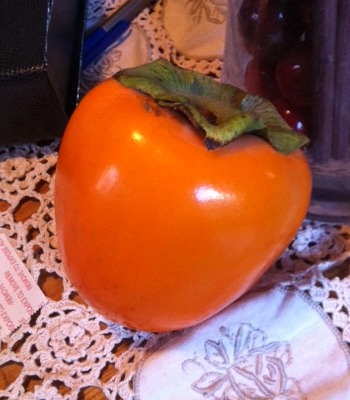 It's been a while since I did one of these! Perhaps the novelty of picking up a mad-looking fruit when we go to the import supermarket wore off for a while - the fruits go in and out a bit with the seasons, but there's still a whole array of potential there. This one came from an eye-catching bright orange pile near the checkouts, where most of the madness seems to be concentrated. It has the same rough shape and leafery as a strawberry without any seeds on the outside, but is about the size of an apple.
It's been a while since I did one of these! Perhaps the novelty of picking up a mad-looking fruit when we go to the import supermarket wore off for a while - the fruits go in and out a bit with the seasons, but there's still a whole array of potential there. This one came from an eye-catching bright orange pile near the checkouts, where most of the madness seems to be concentrated. It has the same rough shape and leafery as a strawberry without any seeds on the outside, but is about the size of an apple.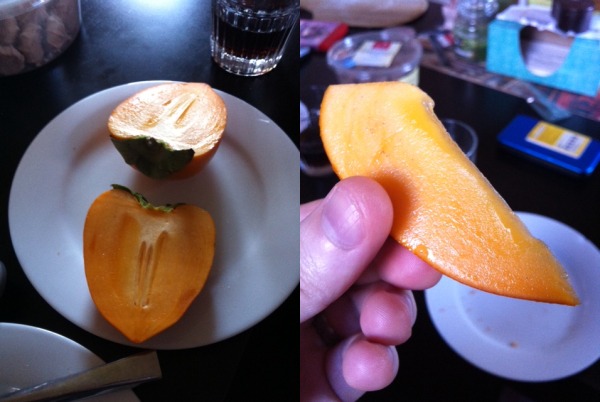
You can just cut it open and reveal a smooth flesh inside with no apparent seeds - all of it can be eaten except the waxy skin. But that generosity comes at a price - this fruit is the exact opposite of juicy, and as soon as you put it in your mouth it forcibly sucks all the moisture out of every corner of it like those hoover things that you get at the dentist. Consequently it's very difficult to actually identify any sort of taste at all before you are entirely absorbed inside-out into it, but after a long dry chewy struggle (and a lot of water) I came up with mango as the closest possible comparison - I couldn't eat very much of it because it's like eating a whole packet of crackers. Apparently you're meant to leave them until they're on the point of over-ripe, at which point the inside becomes more jelly-like and its saliva-absorbing properties get much less severe.
Further reading on Wikipedia tells me that the dry sensation is caused by a property called astringency, caused by chemicals which bind to saliva and shrink bodily tissues. Perhaps by tomorrow I'll just have folded in on myself in a black hole.
2012-11-18 21:50:00
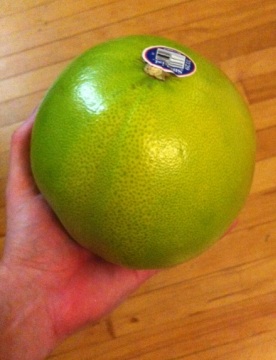 I keep on thinking that I'm going to run out of interesting things to get from Russo's, but they seem to rearrange them all and invent a few more every time we have the chance to go there. This one looks like an unripe overinflated orange, or possibly some sort of alien breast depending on your frame of mind - to me it seems to have chameleon-like properties, as it's one of the range of colours between green and orange that are indefinable to me and it blends in perfectly with the floor in this photograph, but I don't think that this will be a problem for anybody else.
I keep on thinking that I'm going to run out of interesting things to get from Russo's, but they seem to rearrange them all and invent a few more every time we have the chance to go there. This one looks like an unripe overinflated orange, or possibly some sort of alien breast depending on your frame of mind - to me it seems to have chameleon-like properties, as it's one of the range of colours between green and orange that are indefinable to me and it blends in perfectly with the floor in this photograph, but I don't think that this will be a problem for anybody else.As you might guess from just looking at it, it's a very large citrus fruit. The flesh inside is dark pink like a grapefruit, though it's several sizes larger - though having said that, despite its large diameter, it has the skin of a rhinoceros and is considerably smaller on the inside. Its seeds are mostly concentrated right in the middle where the segments meet, so in theory you can scoop them all out at once and eat it in rings like a pineapple.
Its taste is probably most similar to a grapefruit as well, but it doesn't have the bitterness to it, which makes it feel a bit more like an orange instead. The slight extra sweetness is welcome, although its sheer size means that it's unsuitable to use as decoration for your girly drinks.
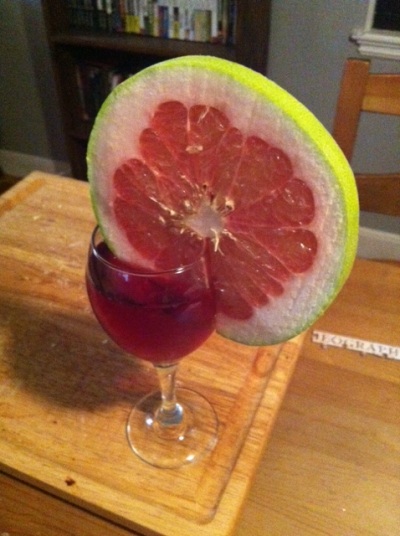
2012-01-15 20:49:00
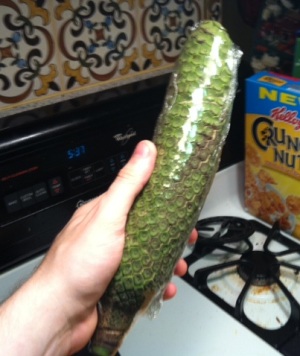 I told you that we were going more often now! This time, I didn't see anything new that looked otherworldly enough to try out (though I was actually tempted to get a couple of rambutans having actually enjoyed them the first time), but this obscene-looking article was spotted by Whitney on the way to the checkout. It's a long thin hard semi-pointed... thing, roughly resembling a green and enlarged pine cone, which looks like some unlikely fruit form of the crocodile - it's very tough, and its skin is divided into these amazing hexagon shapes that you wouldn't think it possible to grow naturally.
I told you that we were going more often now! This time, I didn't see anything new that looked otherworldly enough to try out (though I was actually tempted to get a couple of rambutans having actually enjoyed them the first time), but this obscene-looking article was spotted by Whitney on the way to the checkout. It's a long thin hard semi-pointed... thing, roughly resembling a green and enlarged pine cone, which looks like some unlikely fruit form of the crocodile - it's very tough, and its skin is divided into these amazing hexagon shapes that you wouldn't think it possible to grow naturally.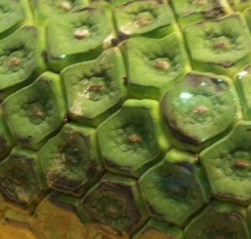 This was in a basket under the name "Monstera" - the name of a species of vine from the rainforests in the south of Mexico. And it does indeed look fairly monstrous - the close-up photograph that I took of its scales could easily be from some sort of forgotten reptile. The fruit itself is from the Monstera Deliciosa - making it, therefore... a Delicious Fruit. At the very least, I can't say that I wasn't warned.
This was in a basket under the name "Monstera" - the name of a species of vine from the rainforests in the south of Mexico. And it does indeed look fairly monstrous - the close-up photograph that I took of its scales could easily be from some sort of forgotten reptile. The fruit itself is from the Monstera Deliciosa - making it, therefore... a Delicious Fruit. At the very least, I can't say that I wasn't warned.It is justified in having that namesake, because as I found out on doing my usual post-Russo's research, this fruit can kill you. That, of course, is such a Daily Mail headline level of overreaction - but it does have at least a base in reality. And not just in the way that a banana could also technically kill you if you froze it and then rammed it up someone's nose. On the vine, it spends one year sitting around ripening, and at this stage it contains such a painfully high level of oxalic acid that it's poisonous. Eating it before it's ready can cause irritation and blistering to the nose, throat, and everywhere, really. But as the fruit ripens, it does something I've never seen any other fruit do - as advised by the Internet, I took it out of its plastic bag and put it in a paper one, left it in the warm kitchen, and within a couple of days the hexagons began crumbling away into individual pieces like so many Knightmare causeways and exposing the edible flesh underneath. If you sit around expecting other fruit to peel itself, you'll be waiting a very long time.
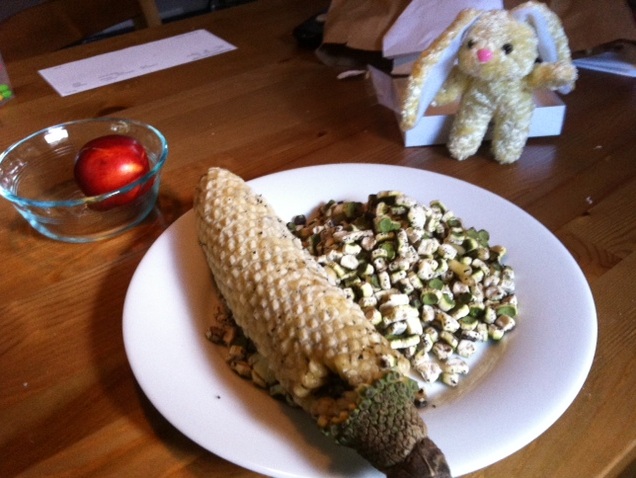
When the fruit has invitingly exposed itself and is non-deadly, it looks rather like an ear of sweetcorn with a solid column in the centre and the edible stuff around the edges - though the individual pieces are much taller. Even at this stage, it still contains a very high level of oxalic acid, and as I have a known elemental vulnerability to it, this was the first fruit on this venture that I haven't actually ingested - my experimentation was limited to chewing and examining the taste before spitting it out.
It has a texture and taste rather like pineapple, but sweeter and without any of the bitterness - the pieces are extremely wet, and it really seems to hold much more juice than you would expect to be able to fit into the small flecks of fruit. I definitely felt some tingling on my lips for a couple of minutes after trying it, and it leaves a rich gluey feeling on the inside of your mouth that makes you salivate a lot afterwards - some people have reported more noticeable side effects, but seemed undeterred by them nonetheless. (Coincidentally, the author of that article got theirs from the very same market last year!) With those reactions, I decided that not swallowing had been a wise decision - and it's a shame, because it really does taste wonderful. It also absolutely filled the living room with its aroma from the moment its scales began falling off - and not having much of a sense of smell, I can honestly only recall thinking of smell as a bad thing up until now, but this smells wonderfully sweet and pleasant, like some sort of air freshener without the artificial undertones to it. I'd honestly hang it up in a room just for that if it didn't attract so many flies.
I've just realized why I have such a sore throat this evening. It tastes so nice, but apparently even if you're very careful with it it'll do its best to get revenge on you. What an evil fruit.
2011-09-05 21:36:00
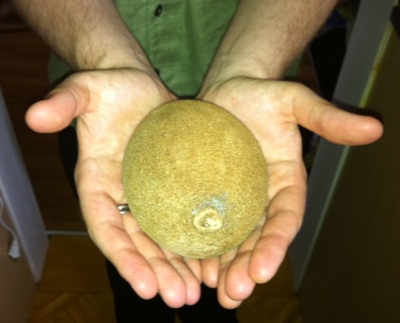 I still haven't quite got over how much more accessible absolutely everywhere seems when you have your own car. I started this little series of entries because actually being able to get to the import supermarket was a special occasion that deserved some recognition, but now we're free to go there whenever we like. But even though our visits are more frequent now, its supply of fruit from other dimensions in space and time has not been exhausted, and this was what I decided to bring back with us last week.
I still haven't quite got over how much more accessible absolutely everywhere seems when you have your own car. I started this little series of entries because actually being able to get to the import supermarket was a special occasion that deserved some recognition, but now we're free to go there whenever we like. But even though our visits are more frequent now, its supply of fruit from other dimensions in space and time has not been exhausted, and this was what I decided to bring back with us last week.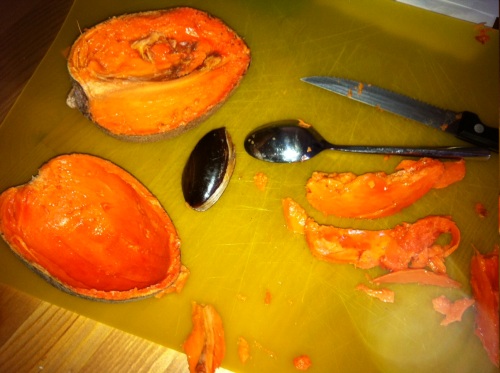 This one isn't nearly as dangerous as some of the other things I've brought back - you can get into it by just piercing and sawing it in half, though the skin can take some punishment. On the inside, it's suddenly an avocado - though an avocado coloured a sort of radioactive orange - and once you've got the single, uncannily shiny seed out of the middle, you can then just spoon out the rest and eat it raw, so it's also one of the least inconvenient fruits I've picked up.
This one isn't nearly as dangerous as some of the other things I've brought back - you can get into it by just piercing and sawing it in half, though the skin can take some punishment. On the inside, it's suddenly an avocado - though an avocado coloured a sort of radioactive orange - and once you've got the single, uncannily shiny seed out of the middle, you can then just spoon out the rest and eat it raw, so it's also one of the least inconvenient fruits I've picked up.The texture is almost exactly the same as an avocado, but it's slightly wetter and juicier. And its taste is... something I can't really adequately describe, though there are a couple of attempts on that Wikipedia page above. If you dispel any citrus notions you have and forget how the fruit called 'orange' actually tastes, it's a bit like what the colour orange would taste like - I'm not really sure that I can do any better than that. We just tried enough of it to taste, and it has to be said that neither of us really liked it very much, though it wasn't exactly bad - and I still consider this choice an extremely successful one, for having discovered a new fruit that can't accurately be described as just a combination of several previously known ones.
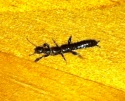 This thing was also living inside, and escaped in a panic when I first halved the fruit - I put it outside. It isn't as leviathan-like as comparing the photos might make it seem - they're not to the same scale and it was less than half an inch long. I can only hope it wasn't one of those foreign species of insects that the customs office are always so worried about, which will upset the balance of the ecosystem in our back garden and cause everything to wither and die within the next few months.
This thing was also living inside, and escaped in a panic when I first halved the fruit - I put it outside. It isn't as leviathan-like as comparing the photos might make it seem - they're not to the same scale and it was less than half an inch long. I can only hope it wasn't one of those foreign species of insects that the customs office are always so worried about, which will upset the balance of the ecosystem in our back garden and cause everything to wither and die within the next few months.2011-08-23 18:59:00
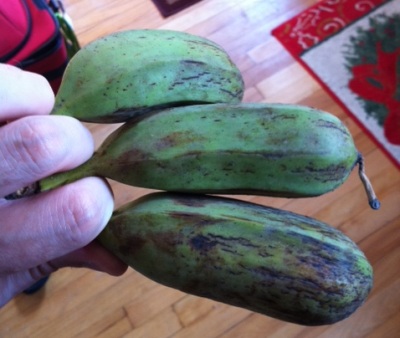 This time, I was brought back to the magic fruit shop by a sudden craving for actual meat-like Danish/Irish bacon instead of the rectangular cuttings of pure fat that America attaches to the word. I had to smile to myself when I realized that thanks to our recent life transition, I had got there in less than Infinite Dreams' playing time (6:09) instead of the hours-long expedition that it used to be. A quick look around the boxes of weird things and I was home again in time for breakfast.
This time, I was brought back to the magic fruit shop by a sudden craving for actual meat-like Danish/Irish bacon instead of the rectangular cuttings of pure fat that America attaches to the word. I had to smile to myself when I realized that thanks to our recent life transition, I had got there in less than Infinite Dreams' playing time (6:09) instead of the hours-long expedition that it used to be. A quick look around the boxes of weird things and I was home again in time for breakfast.Getting into this fruit is a task in itself, because the skin is thicker than the plating on the average ironclad warship. You can't peel them like bananas as God intended without utterly destroying the fruit inside, and instead need to knife them lengthways and hack off the outer skin, leaving a yellowish oblong mass that tastes of very little except perhaps starch with a hint of chalk. You can, however, chop them up into discs and fry them - after which they will come out with a crispy skin and taste oddly like roast potatoes, nothing like what you would expect from something so outwardly banana-like. This fruit would appear to have taken the wrong career path somewhere in its evolution, and would be much better suited as a vegetable.
I've actually just found a Blogspot journal called Fruitectives that's doing this exact same thing, but I'd like to think that my effort is still worthwhile due to not using the word "nommability".
2011-07-12 09:37:00
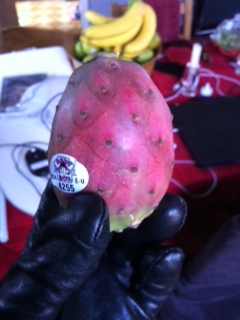 While we were at the Ford dealership we went to the market full of weird and wonderful things across the road again. At this time of the year, there are rather fewer of the more demented fruits that are within the range that I would consider trying - the rambutan and dosakai were absent this time - but I did find something that looked subtly geometric with apparent rivets.
While we were at the Ford dealership we went to the market full of weird and wonderful things across the road again. At this time of the year, there are rather fewer of the more demented fruits that are within the range that I would consider trying - the rambutan and dosakai were absent this time - but I did find something that looked subtly geometric with apparent rivets.The first thing to know about this fruit is that it's more quietly dangerous than the others, hence the glove in the photograph. It looks and feels innocent enough with the outer cactus-like parts removed, and you won't feel anything at first, but a while after picking it up, you'll suddenly get pains in your palms and notice that your hands are covered in tiny spines that it's painlessly shoved into your skin while you weren't looking. So if you haven't handled it with respect, you will be spending some time wrapping duct tape around your hands and ripping it off to extract them from just under your epidermis.
Preparation is easy enough if you take the right precautions - cut the ends off, make an incision and then invert the fruit so that a juicy sphere falls out of the skin. This edible part has a taste that can only be described as exactly halfway between a cucumber and a watermelon, while not being more recognizable as one or the other.
That guide says that you can just eat the whole thing, seeds and all, but they're much more formidable seeds than either of its taste neighbours and I found it to be like swallowing an unpleasant spoonful of slightly juicy lumps. Therefore I put it in a blender and turned it into a juice to have the rest of it. It's a reasonably nice taste, but you don't get more than about a quarter of a cupful out of it, and you're always going to be paranoid about having let stray spines get into the part you're eating. With this risk-benefit analysis, I can find no real point to this fruit whatsoever. Blend a watermelon and cucumber together instead, and add a heap of red food colouring so that it stains your kitchen in an authentic manner.
2011-04-10 15:05:00
 We went to the big international fruit and vegetable market with my parents this weekend. I should say first of all that despite the weird and wonderful array of things on offer there, I still absolutely refuse to believe that this rainbow-coloured corn exists. I could accept that they might come in colours other than the traditional yellow, but not that they grew in a variety pack like a natural box of Fruit Pastilles.
We went to the big international fruit and vegetable market with my parents this weekend. I should say first of all that despite the weird and wonderful array of things on offer there, I still absolutely refuse to believe that this rainbow-coloured corn exists. I could accept that they might come in colours other than the traditional yellow, but not that they grew in a variety pack like a natural box of Fruit Pastilles.The first time we went there, I said that each time we went I would bring back something that I hadn't tried before and describe the taste experience. There's no shortage of things there to choose from in that category, because most of them aren't even from this planet - this time, I was a little more adventurous and selected something that looked more likely to put up a fight.
There's a guide to preparing them here - underneath the thin skin, what you get inside is a round sticky translucent white sphere, a bit like a pickled onion and - now that I come to think of it - uncomfortably like an eyeball. The seed is inside this, and you can either cut it out or eat around it.
And it has a taste not incomparable to a plum, though slightly chewier - it has a nicely sweet taste, and I'd probably have them again. The only thing that I don't like about them is that even when you've got the seed out, a woody residue remains bonded to the inside edge of the flesh, but the site says that this is all right to ingest.
2010-10-03 14:04:00
 This weekend, Whitney and I took a shopping bag out and boldly went one and a half miles to a family-run supermarket that's very popular in the area. I had thought from the description that it was a small corner shop, but as I discovered when we arrived, it's a large sort of combined market and garden centre with products from all around the world.
This weekend, Whitney and I took a shopping bag out and boldly went one and a half miles to a family-run supermarket that's very popular in the area. I had thought from the description that it was a small corner shop, but as I discovered when we arrived, it's a large sort of combined market and garden centre with products from all around the world.What fascinated me the most were the fruits and vegetables on display, which started off as recognizable on the displays outside but quickly turned into ones that I had never seen before - things that looked like familiar ones such as apples or cauliflowers but were a different colour or longer or thinner, to things that just defied description or comparison to anything I'd seen before, which were purple and yellow or covered in Fibonacci-sequenced huge spikes. Faced with this interplanetary array, I decided to get one to try for ourselves, but kept my ambitions down by selecting one of the ones that didn't look actively hostile.
I wanted to try it completely blind before looking up what it was, but Whitney made the very good point that it might be poisonous when raw or only edible by dogs, so we looked up its name online when we got home.
The taste is... rather a lot like cucumber, but with a tougher texture (or maybe this one isn't ripe yet). In the middle, though, this changes into something almost like a lemon - the seeds are soft, so you can eat them, but the taste is a bit too sour to eat as part of a salad or anything. There are various recipes for using it as part of a curry.
2010-08-02 10:18:00
 Track the T
Track the T